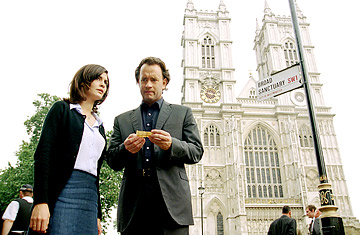
Tom Hanks, right, and Audrey Tautou in The Da Vinci Code.
With the haunting tones of a single violin, the camera follows a ray of light across the dark marbled floor to an early Baroque painting by Caravaggio. We then pan up to the frescoed ceiling, and slowly back down to the sacred altar where a large, leather-bound volume of the Gospels and a silver chalice rest side by side. Finally, the lens focuses back along the long central nave of the 13th century Roman church, toward the entrance where a nun is slowly closing the two heavy oak doors. The quiet is broken with the sudden loud clank of the doors' iron bolt being lock-shut into place.
Welcome to the latest episode in the Catholic Church's ongoing showdown with the Da Vinci Code blockbuster series of books and film. Producer-Director Ron Howard has been banned from entering any of Rome's many historic basilicas to shoot scenes for his upcoming movie Angels and Demons, currently being filmed on location in the Eternal City. The Italian Bishops Conference responded with the blanket "no" after Howard requested filming inside two Rome churches, Santa Maria della Vittoria and Santa Maria del Popolo, the second of which houses two Caravaggio masterpieces: "The Crucifixion of St. Peter" and "The Conversion of St. Paul."
The film, the prequel to The Da Vinci Code, again stars Tom Hanks in a thriller based on the book of the same name by Dan Brown. The Da Vinci Code angered some Catholics from the moment it was published, but the Vatican hierarchy waited a few years before speaking out. The current Secretary of State Cardinal Tarcisio Bertone was the Archbishop of Genoa in 2005 when he blasted Dan Brown's Catholic-inspired fiction, telling a Vatican Radio reporter that "there is a strategy in this castle of lies," and urging people to resist the temptation of reading the hyper-popular novel.
When the Da Vinci Code film came out, Vatican officials again denounced the sensationalized version of events in Catholic history and its cast of highly unappealing church figures, including a homicidal albino monk from the conservative lay group Opus Dei. Perhaps most troubling to the church, however, is the basic premise that Jesus married Mary Magdalene and their descendants formed the blood line that church officials kept secret for centuries.
Giving the keys of historic Roman churches to Howard, Brown and Hanks to help them put their vision on film, in the view of some, could risk giving the impression that the Catholic hierarchy sanctions the version of events. Critics of that view argue that Code is simply a work of fiction, and why not let the beauty of the basilicas come to life on film? Yet others are not as charitable. "I'm still trying to decide whether viewers are sophisticated enough to distinguish between fiction and accepted theology," wrote one blogger. An Italian Bishops Conference spokesman said the ban was imposed because Brown's vision "does not conform to our views." Yet some note that plenty of movies that were far out of step with Church teachings — such as Dogma, a controversial 1999 film that depicts renegade angels and an abortion clinic worker — have been given permission to film inside Catholic churches.
Indeed the ability to propagate its doctrine while managing to embrace popular culture has been a historic strength of the Church. The late 16h century painter Caravaggio himself, whose masterpieces are Church treasures, was hardly a saint. He was once convicted of murder and was infamous for his wild lifestyle. In The Da Vinci Code, at least, the murders are only onscreen.
